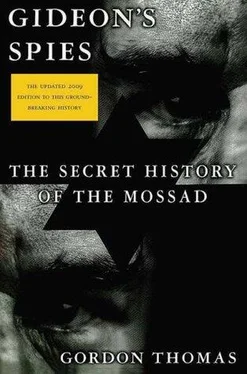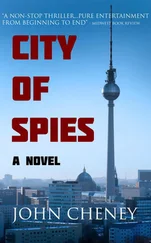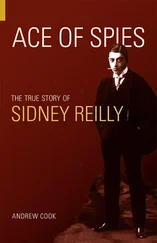During the meeting, Ehrman and Musa Kusa took turns using a telephone in an adjoining room to make calls. Ehrman’s were to prime minister Tony Blair, who was on a visit to his Sedgefield constituency in the north of England. Using a second phone call, Blair kept President Bush in the White House updated on progress. Kusa’s calls were to a phone in a Bedouin tent where Gadhafi was enjoying another of his desert sojourns.
In the preceding months, Kusa had, under Libyan diplomatic passport, traveled to London several times. As the man most trusted by Gadhafi, his mission was to agree to a text that would ensure the Libyan leader did not lose face and satisfy the British team that he could not renege. In an MI6 safe house near Gatwick airport, Kusa and document drafters from the Foreign Office agonized over every word. Time and again, when a breakthrough seemed to be close and a draft was sent to Libya on a secure fax, it came back with suggestions and amendments that were unacceptable to the Foreign Office.
A further complication was Kusa’s suspicion of the need to involve Washington. Initially the Bush administration was also dubious about approving any deal with Libya. But as the secret meetings went on, the CIA asked to participate. Again Kusa was hesitant at their presence. He feared that Israel would learn of the plan from the CIA and possibly sabotage it. A Washington official involved in the negotiations said later: “Kusa was paranoid that the Israelis would want to torpedo the negotiations so that it could attack Gadhafi’s weapons sites. The Brits were finding that trying to do a deal with Gadhafi involved a lot of walking on eggs without breaking one.”
It had been like that from the August day in 2002 when Mike O’Brien, the Foreign Office minister, had visited Gadhafi in his desert tent. He was the first British envoy to do so. He was kept waiting for several hours before two female bodyguards finally ushered the gently perspiring minister into Gadhafi’s presence.
“Gadhafi sat with dark glasses on and spoke through a translator, though I knew he had learned English at a course in England. When it became appropriate I raised the matter of his weapons of mass destruction. To my astonishment he did not deny he possessed them, adding that this was a serious issue. Time and again he emphasized he was genuinely interested to improve relations with the West and in particular to attract foreign investments to the Libyan oil and gas industries,” O’Brien later recalled.
O’Brien returned to London convinced that Gadhafi was “genuinely ready to do a deal.” But there was still a way to go. O’Brien made further visits to Libya. Though he was certain he had taken every possible precaution to maintain secrecy, the deep-cover Mossad agent in Libya had picked up his trail.
In Tel Aviv, Meir Dagan decided to fly to London. He arrived on the eve of the Iraqi war. During his visit Dagan managed to meet with Scarlett and Manningham-Buller and the man Scarlett was due to replace at MI6, Sir Richard Dearlove. Later it emerged that Dagan, in his usual blunt manner, had told the intelligence chiefs, according to one Israeli source (who spoke to the author): “Be assured that Israel will not impede your plans. But I do expect you not to try and hoodwink us.”
In October 2003, with the initial Iraqi war offensive over, O’Brien was asked by Gadhafi to arrange for a team of British weapons experts and intelligence officers from MI6 and the CIA to inspect Libya’s weapons of mass destruction sites. One expert had a close relationship with Mossad. His recall perfectly captured the atmosphere on the trip.
“The Libyans showed us everything. It was a case of: on your right, our famous chemical weapons; on your left, our secret uranium centrifuge ; and tomorrow you’ll see our biological weapons. At the end of our visit it was clear that while Libya had not yet acquired nuclear weapons capability, it was closer to having one than we had realized. It was also working on a variety of delivery systems, including ballistic missiles with a range capable of hitting any major city in Europe. The truth was that Gadhafi posed a far greater threat than Saddam did.”
But with Saddam defeated, the negotiators in London decided to exert pressure on Gadhafi. A team of senior American negotiators from the State Department flew to London. They told Kusa they had “overwhelming” evidence that Libya could not have developed its programs on weapons of mass destruction without the help of Iran and North Korea.
“As a fully paid up member of the ‘axis of evil’ it was made clear to Kusa that Libya remained very much on our target list,” an official who attended the meetings said (to the author).
Nelson Mandela, the retired South African leader, was called upon to deliver a warning to Gadhafi that he must act—or face the consequences. Mandela called Bush and said that Gadhafi was “very serious about making an agreement.”
But still the cautious fencing persisted between Libya and the negotiators. Finally it was made clear to Kusa that time was running out if Gadhafi continued to prevaricate. The deadline was January 1, 2005. The Traveller’s Club meeting was convened.
The key part of the agreement was to be contained in the broadcast Gadhafi would make on Libyan television that evening. The text was sent to Tripoli for endorsement. A copy was faxed to Condoleezza Rice in Washington, whom Bush had asked to oversee the negotiations. She asked for minor changes to wording and emphasis. These were conveyed to Kusa.
The smiling intelligence chief said, “A woman’s prerogative. But these are acceptable. We have a deal.”
The historic announcement was to be made on Libyan television that night. The BBC monitoring unit at Caversham was sent a copy of the text and asked to monitor the broadcast. Shortly after the meeting at the Traveller’s Club broke up, a copy of the text was handed to Nathan. In minutes it was on the desk of Ariel Sharon.
Having read the document, the Israeli prime minister told Dagan that as far as Libya went, Mossad was to maintain its close surveillance on the country. A copy of the document was sent to the third-floor archives and inserted in the Gadhafi psychoprofile. It contained a report that Musa Kusa had been one of the planners behind the bombing of the Pan Am jet over Lockerbie in which 270 people had died fifteen years before in the very week that Gadhafi was welcomed back from being a tyrant to a statesman.
In London, Jack Straw, the foreign secretary, praised Gadhafi’s “huge statesmanship.”
In Washington, the State Department announced that American companies with contracts on Libyan oilfields due to expire in 2005 were being allowed to open talks in Tripoli to extend their concessions.
In Paris, the French government confirmed that Kusa was still wanted in connection with the 1989 bombing of a French UTA airlines DC-10. But a spokesman admitted that given the spy chief’s diplomatic status, it was “highly unlikely he will ever be questioned.” In the French capital another long-running investigation was on the move again.
Mossad had continued to monitor events about the deaths of Princess Diana and Dodi al-Fayed. Faced with mounting public disquiet in Britain, the new Royal coroner, Dr. Michael Burgess, had overruled his predecessor’s decision not to hold an inquest. He announced an inquiry, and the investigation would be headed by the former London Metropolitan police chief Lord Stevens. Stevens traveled to Paris to inspect the crash site. Among the media scrum that accompanied his every move was a Dutch-born katsa, Piet, a member of the Mossad Paris Station. Among those he had recruited was a mahuab, a non-Jewish informer, in the Paris police department. She was code-named Monique.
Читать дальше












